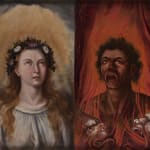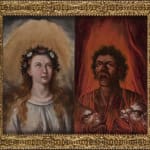THE BLESSED SOUL AND THE DAMNED SOUL
Unidentified artist, Vice Royalty Of Peru, 18th Century
Oil on Canvas.
57.3 x 69.3 cm.
Provenance
Private Collection, Spain
The pictorial representation of the representation of the intangible has posed a great llenge for the artists of each generation since antiquity. In this the portrayal of the soul gradually...
The pictorial representation of the representation of the intangible has posed a great llenge for the artists of each generation since antiquity. In this the portrayal of the soul gradually took shape through a dels until a stereotype was established. The complex imaginary curation of what occurs after death began to coalesce artistically the medieval period due to its profoundly religious aspect. Depictions tended to include what were known as the “four last things”. which were the stages awaiting mankind at the end of his life: death, iudoment, heaven and hell. On certain occasions, as seen here, these were reduced to two: heaven and hell, these being the two potential final destinations of the soul after death.
With the sole purpose of further accentuating the believer's faith, the representation of heaven and hell was humanized, taking the form of the blessed soul (the embodiment of bliss, in an attitude of peace and serenity), and the damned soul (personification of pain and suffering amidst the flames of hell). A woman with a kind of mystical aura, accentuated by her view of the heavens, expressing peace, is generally associated with the blessed soul.expressing peace. Her antithesis, meanwhile, is reflected in the damned soul, in the throes of agony and despair, in a final attempt to escape hell.
The rise in depictions of this kind came about following the Council of Trent (1545-1563), where the existence of purgatory was recognized, being the state reserved for those who, having died in God's grace, needed further purification before entering heaven. The Jesuit Order also contributed to the dissemination of this notion of different fates or conditions of the soul during the 17th century, through devotional books with written tales accompanied by prints that served to consolidate the iconography figuratively. We know of examples from around 1600 by Flemish engravers such as Pieter de Jode I and Karel van Mallery alluding to the four fates of the soul, which subsequently inspired contemporary works by artists such as the Italian sculptor Giovanni Bernardino Azzolino, and his wax models belonging to London's Victoria & Albert Museum. Major geniuses of the art world, such as Gian Lorenzo Bernini, also dared to tackle this subject matter, as demonstrated by his famous sculptural pair, Anima beata and Anima dannata, executed in 1619, and preserved today at the Spanish Embassy in the Holy See. Pictorially, other artists also portrayed these fates of the soul in accordance with preestablished engraved models, as in the case of Francisco Ribalta who, in about 1010, executed a pair of paintings as devotional works intended for the king's oratory in the Palace of Aranjuez, currently preserved in the Prado Museum's collection in Madrid.



